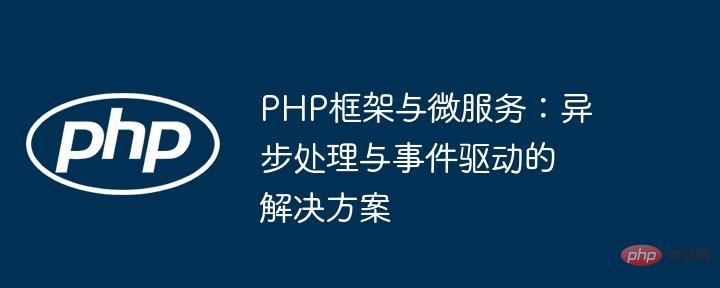Home >Backend Development >PHP Tutorial >PHP framework and microservices: asynchronous processing and event-driven solutions
PHP framework and microservices: asynchronous processing and event-driven solutions
- WBOYWBOYWBOYWBOYWBOYWBOYWBOYWBOYWBOYWBOYWBOYWBOYWBOriginal
- 2024-06-02 18:37:00398browse
The PHP framework improves efficiency by integrating asynchronous processing and event-driven architecture: Asynchronous processing: allocates background tasks, allowing the main thread to handle other tasks at the same time. Event-driven architecture: Separate events and listeners, trigger predefined operations when events occur, and achieve flexible responses.

PHP Framework and Microservices: Asynchronous Processing and Event-Driven Solutions
Introduction
As applications become more complex and multitasking, asynchronous processing and event-driven architecture have become essential considerations. Integrating these features into the PHP framework can improve scalability, performance and responsiveness. This article will explore how the PHP framework implements asynchronous processing and event-driven architecture, and explain it in detail through practical cases.
Framework integration
- Symfony: Symfony Messenger component provides a flexible asynchronous messaging system that allows developers to easily Separate tasks and events.
- Laravel: The Laravel queue system allows you to easily create and manage background jobs for asynchronous processing.
- Zend: Zend Event Manager allows you to attach event listeners to specific events, implementing an event-driven architecture.
Asynchronous processing
Asynchronous processing involves assigning time-consuming or resource-intensive tasks to background processes while the main thread continues to handle other tasks. This enables applications to perform these tasks efficiently and in a non-blocking manner.
Practical Example: Sending Email
use Symfony\Component\Mailer\MailerInterface;
use Symfony\Component\Mime\Email;
class EmailService
{
private $mailer;
public function __construct(MailerInterface $mailer)
{
$this->mailer = $mailer;
}
public function sendEmail(string $recipient, string $subject, string $body)
{
$email = (new Email())
->from('sender@example.com')
->to($recipient)
->subject($subject)
->text($body);
$this->mailer->send($email);
}
}In this example, the email sending task is delegated asynchronously to a background process, allowing the main thread to continue processing other requests.
Event-driven architecture
Event-driven architecture is a design pattern that involves the separation of events and listeners. When a specific event occurs, a notification is posted to the listener, triggering a predefined action. This gives applications the flexibility to respond to various events in the system.
Practical case: User registration
use Zend\EventManager\EventManager;
use Zend\EventManager\SharedEventManager;
class UserService
{
public function registerUser(string $username, string $password)
{
// 触发用户注册事件
$sharedEventManager = SharedEventManager::getInstance();
$sharedEventManager->trigger('user-register', $this, [
'username' => $username,
'password' => $password,
]);
}
}
$eventManager = new EventManager();
$eventManager->attach('user-register', function ($event) {
// 记录用户注册事件
// ...
});
$userService = new UserService();
$userService->setEventManager($eventManager);
$userService->registerUser('john', 'password');In this example, the user-register event is triggered when the user registers, allowing additional monitoring The server performs a specific action, such as logging an event or sending a welcome email.
Conclusion
By integrating asynchronous processing and event-driven architecture, PHP framework can help you create scalable, efficient and responsive applications. These technologies allow you to dispatch complex tasks to the background and respond flexibly to events in the system, improving the overall performance and user experience of your application.
The above is the detailed content of PHP framework and microservices: asynchronous processing and event-driven solutions. For more information, please follow other related articles on the PHP Chinese website!
Related articles
See more- PHP framework learning: 8 PHP development frameworks that must be used for efficient web development
- How to implement multi-table query in thinkPHP framework
- ThinkPHP framework role
- The official version of PHP framework CodeIgniter 4.0 is released!
- What microservice frameworks are suitable for Go language development?

